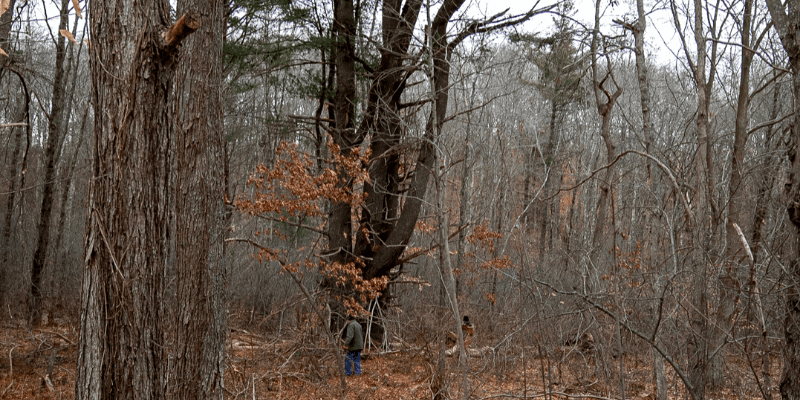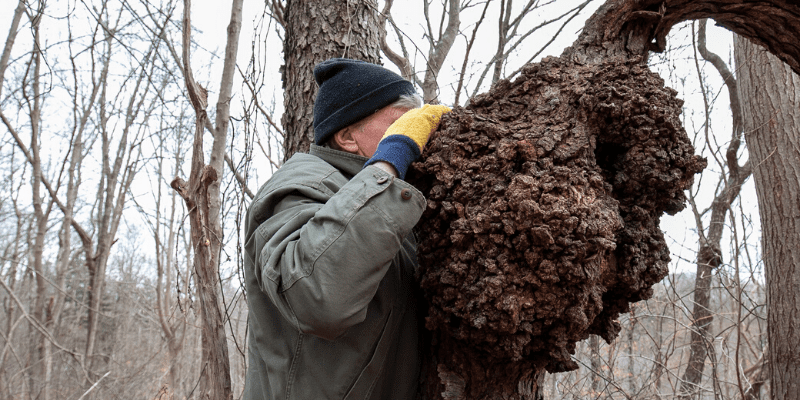Pike Messenger peers into a split open burl on a cherry tree.
The entrance to Donovan Hill Trail is tucked into the back of Donovan Fields. Walking through the fields, you are given an indication of the makeup of the woods. Here a large white pine, there a slender gray birch, and cherry growing as seedlings and mature trees.
From the trailhead you’ll move along a straight path, flanked by beeches, still clinging to their leaves. Beech leaves decompose slowly, notice how the ground is carpeted with them. Beneath this wet mat of leaves, the tree’s root system is wide, shallow and water loving. Beeches reproduce by their seeds and also through their root systems. Notice how the larger beeches you’ll see are surrounded by their offspring. As these are the result of asexual reproduction, these have all of the same DNA as the parent tree. Beech seeds are a favorite food of animals.
When you reach the fork in the trail, head to the right.
Native cherry trees, when young, can often be confused with invasive buckthorn. There are several ways to differentiate them, however. Try this one: cherry has a distinct taste and smell. Peel a small patch of bark from a twig and take a sniff. If you’ve found a young cherry then you should detect a sour smell. Though the cherry starts out smooth, the mature trees have distinct rough and dark bark. Keep an eye out for the cherry with the large burl on your right. Burls are caused by stress to the tree such as injury, virus, fungus, insect infestation or mold growth. This causes a distortion of the wood. The grain of burls is prized by woodworkers.
Route 22, to your southeast, follows along the Ipswich/Essex watershed boundary for a while, meaning that from these hills you can look down into two separate watersheds. As you descend the hill, keep in mind the interplay of topography and water. See how the woods change as you move down the hill. Here there are white spruce, which like beech like wet but well-drained soil. The groundwater here drains into a small creek. As you cross over the bridge, take stock of what other plants grow here. Red maples also thrive in wet lowlands and in the shady cooler low lands there are many hemlocks.
When you cross the stone wall, continue straight to the gate. You’ll notice a Greenbelt kiosk to your right when you pass the stone wall. As you move forward, the kiosk should be behind you and to the right. When you reach the gate you will see an ECTA trail marker indicating that you should continue to the left.

Notice the massive white pines in the area with several trunks, due to leaders being damaged then young and side branches growing up to replace them. The eastern white pine is the tallest tree in eastern North America and mature trees like you see here are sometimes 200–250 years old.
As you continue, you will see large stands of white and gray birch. Birches are pioneer species that will grow quickly in cleared land. They are not long-lived trees. White birch (or paper birch) bark is weather-resistant and a downed tree will often rot away leaving the bark still mostly intact. Can you see evidence of this around you? Gray birches can be differentiated from white birches by the bark, as the gray birch’s bark does not as easily peel away. White birches grow larger, their upper branches are reddish. Gray birch bark isn’t as white and its twigs are gray-black and spikey.
Cross the road to the trail leading up to the Sagamore Hill USAF Geophysics Lab Radio and Solar Observatory. A chain link fence surrounds the property. Across the field south of the observatory, you may choose to take a detour to Chief Masconomet’s gravesite. Please be quiet and respectful in this space. When you are ready to continue, take the trailhead opposite from where you entered the road. This will lead you back downhill to the fork in the trail where you took your first right. Continue straight down the trail and back to Donovan Field.
After you’ve walked the Donovan Hill Trail, try others in the area, keeping an eye out for natural cues around you. Can you see the signs of how land, water and people have impacted the landscape? For a start, try the trails at our Riverbend headquarters in Ipswich and other ECTA trails, which you can find online at www.ectaonline.org


Rachel, that trail guide to Donovan is well done. You are a good writer and a good naturalist!
Jim
Wow! Thank you, that’s quite a compliment coming from you, Jim. I owe any “expertise” I have to Pike.